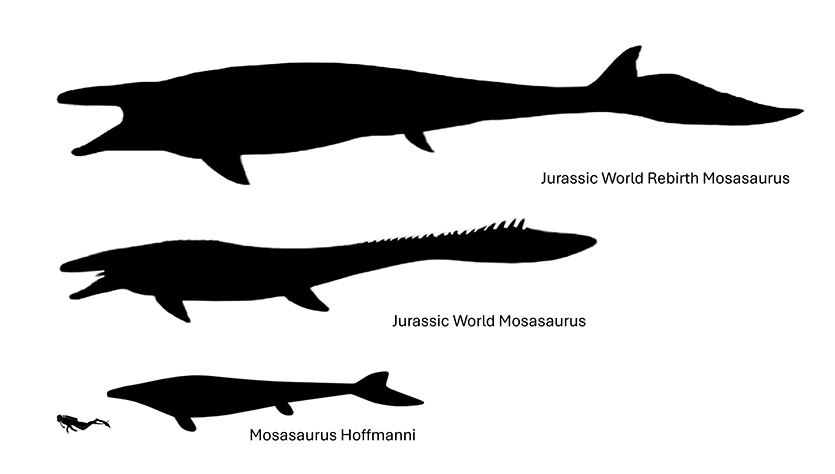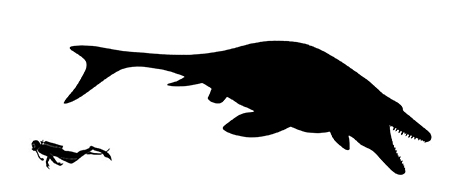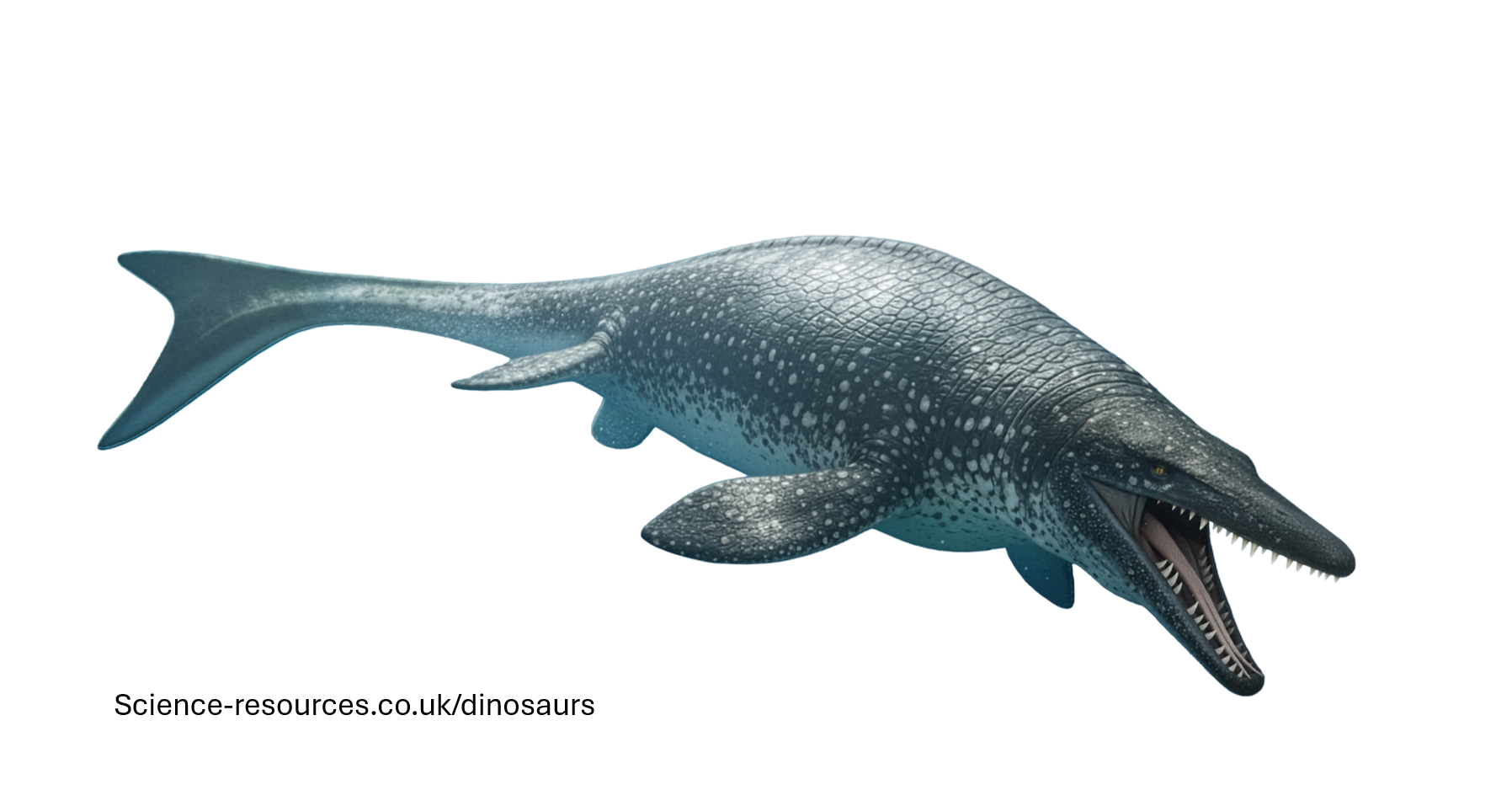i-How: How big was Mosasaurus (and other amazing facts)
Length: The largest species ofcould grow to over 15 meters (50 feet) long. It had a streamlined body, a skull bristling with teeth, a barrel-like trunk, and a long, powerful tail. Mosasaurus was an apex predator that used ambush tactics, not speed, to hunt. It would hide and wait for prey like ammonites, turtles, and sharks, then use a burst of speed for a swift attack. Its powerful jaws and double-hinged lower jaw allowed it to swallow prey whole or tear large items into bite-sized chunks. The Mosasaurus featured in the Jurassic World and Jurassic World Rebirth films is an impressive sight, but how closely does it resemble the real-life marine reptile from the Cretaceous period?
Dinosaurs
Contents:
How big was Mosasaurus?
How did Mosasaurus hunt?
How Accurate is the Jurassic Park Mosasaurus?
Size and body shape
Tail and propulsion
- Jurassic World: Uses its large flippers for propulsion, and the tail has a large, scaly fluke.
- Real life: Propulsion came from its tail fluke, which was a soft-tissue structure, and the flippers were used for stability.
Head and teeth
- Jurassic World: Features jagged, non-uniform teeth that are often exposed and a more "shrink-wrapped" appearance in later versions. It also has baleen whale-like throat grooves in the Rebirth version, which is inaccurate for a reptile.
- Real life: Had smooth teeth hidden by lips, similar to a monitor lizard. Its brain was also likely smaller and narrower.
Colour
- Jurassic World: Coloured in shades of blue and grey.
- Real life: Likely had a darker, counter shaded coloration (darker on top, lighter on the bottom).
Other differences
- Jurassic World: Exhibits acrobatic breaching behaviour.
- Real life: The full extent of its behavioural capabilities is not fully known, but its anatomy makes highly acrobatic breaches unlikely.
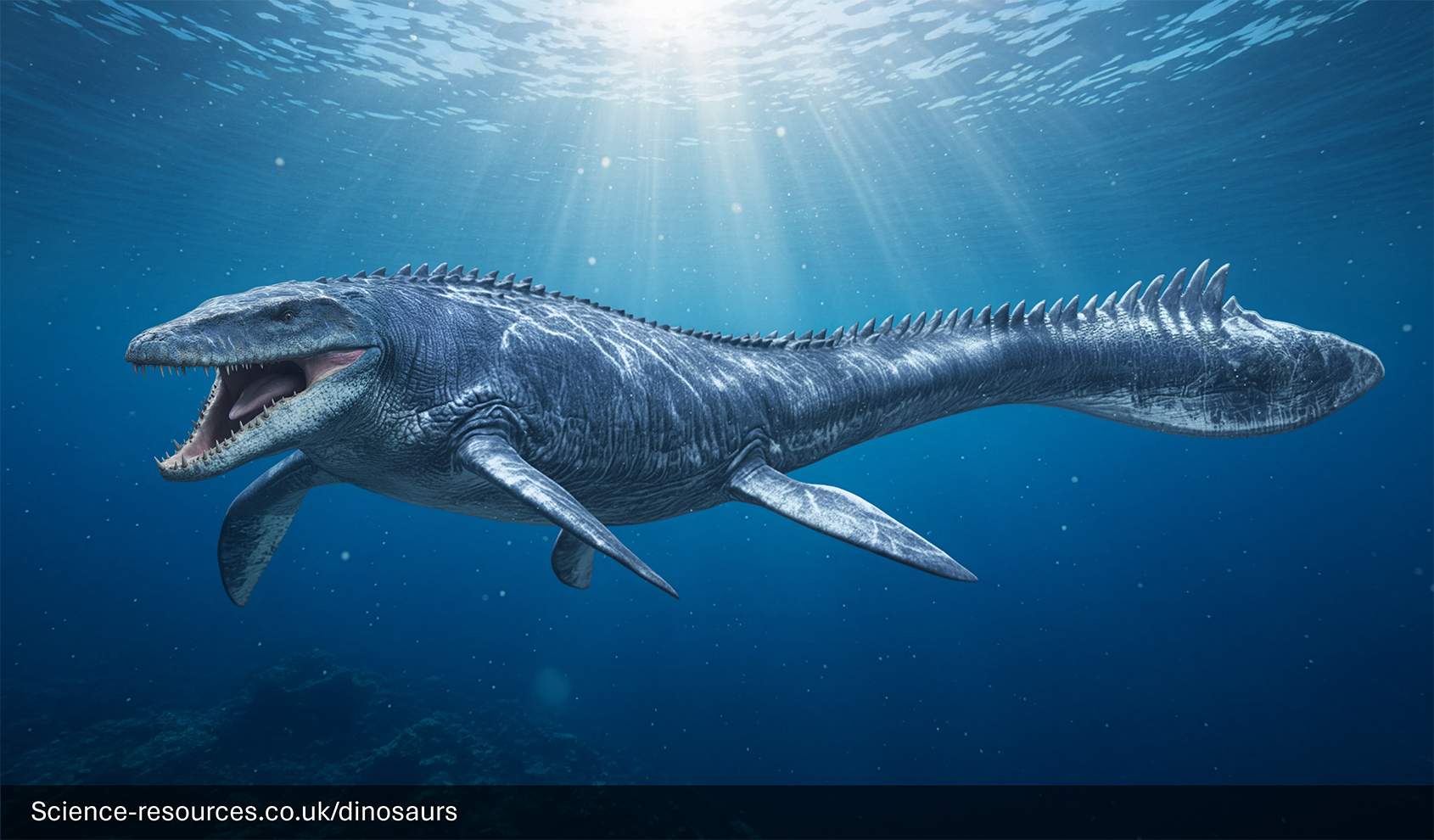 Jurassic World Mosasaurus (Image source: https://science-resources.co.uk/KS2/Dinosaurs/Mosasaurus.html)
Jurassic World Mosasaurus (Image source: https://science-resources.co.uk/KS2/Dinosaurs/Mosasaurus.html)
 Jurassic World Rebirth Mosasaurus (Image source: https://science-resources.co.uk/KS2/Dinosaurs/Mosasaurus.html)
Jurassic World Rebirth Mosasaurus (Image source: https://science-resources.co.uk/KS2/Dinosaurs/Mosasaurus.html)
Jurassic World Mosasaurus size comparison
|
Left: Jurassic World Mosasaurus compared to an average-sized adult human
Right: Actual Mosasaurus size compared to an average-sized adult human
(Image source: https://science-resources.co.uk/KS2/Dinosaurs/Mosasaurus.html)
Did Mosasaurus have a forked tongue?
Yes, it is widely believed that mosasaurs had a forked tongue, similar to their modern relatives like snakes and monitor lizards. This is based on their shared anatomy, such as a paired openings in the palate for the vomeronasal organ (or Jacobson's organ), which they likely used to "taste" their environment for chemical traces.
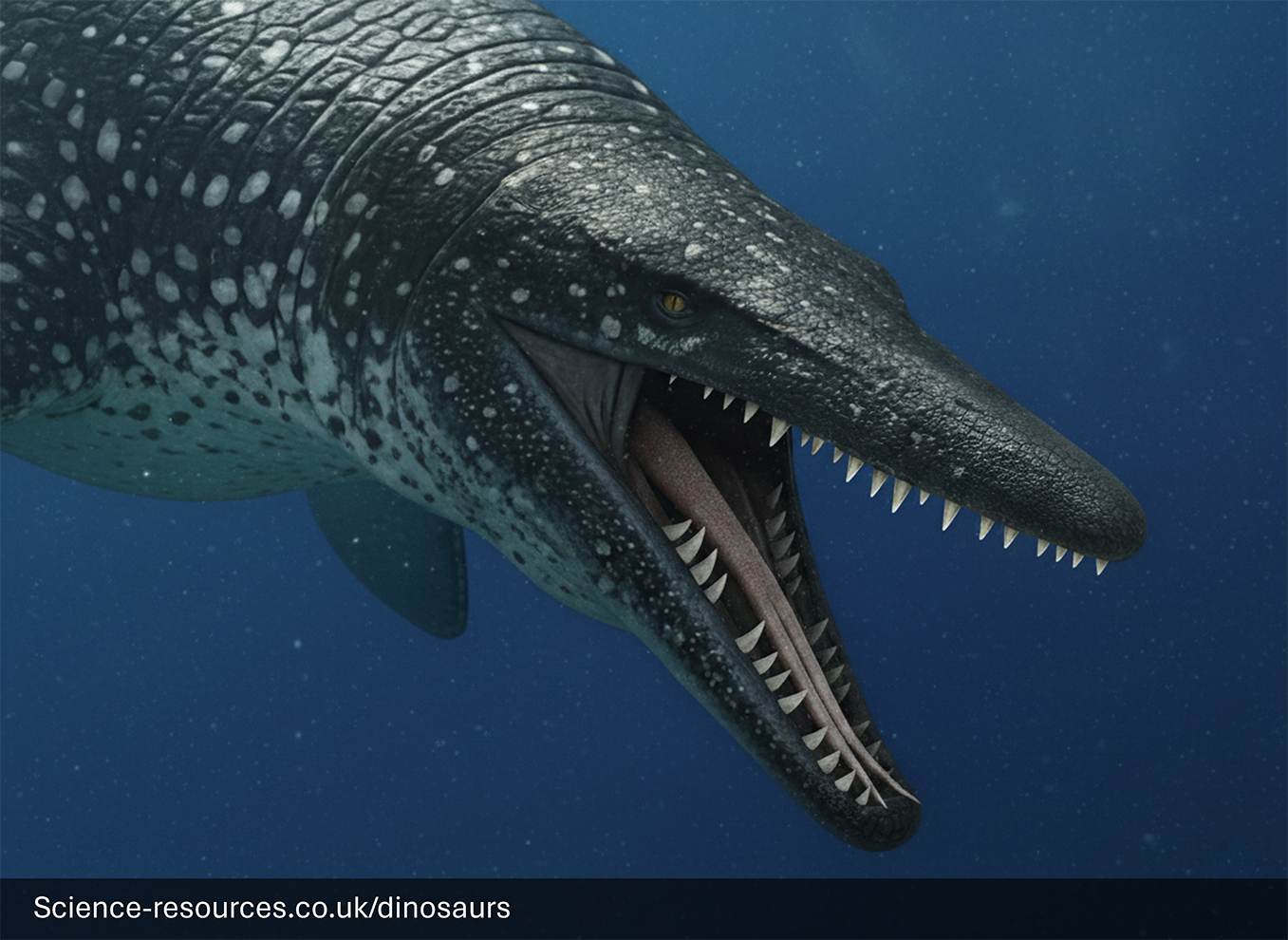
Mosasaurus with a forked tongue (Image source: https://science-resources.co.uk/KS2/Dinosaurs/Mosasaurus.html)
How did Mosasaurus look?
Mosasaurus had a streamlined skull with many sharp teeth, perfect for catching its prey. Its midsection was barrel-like, and it had a long tail for powerful swimming. It also had two sets of fins, one set at the front and one at the back, to help it steer through the water.
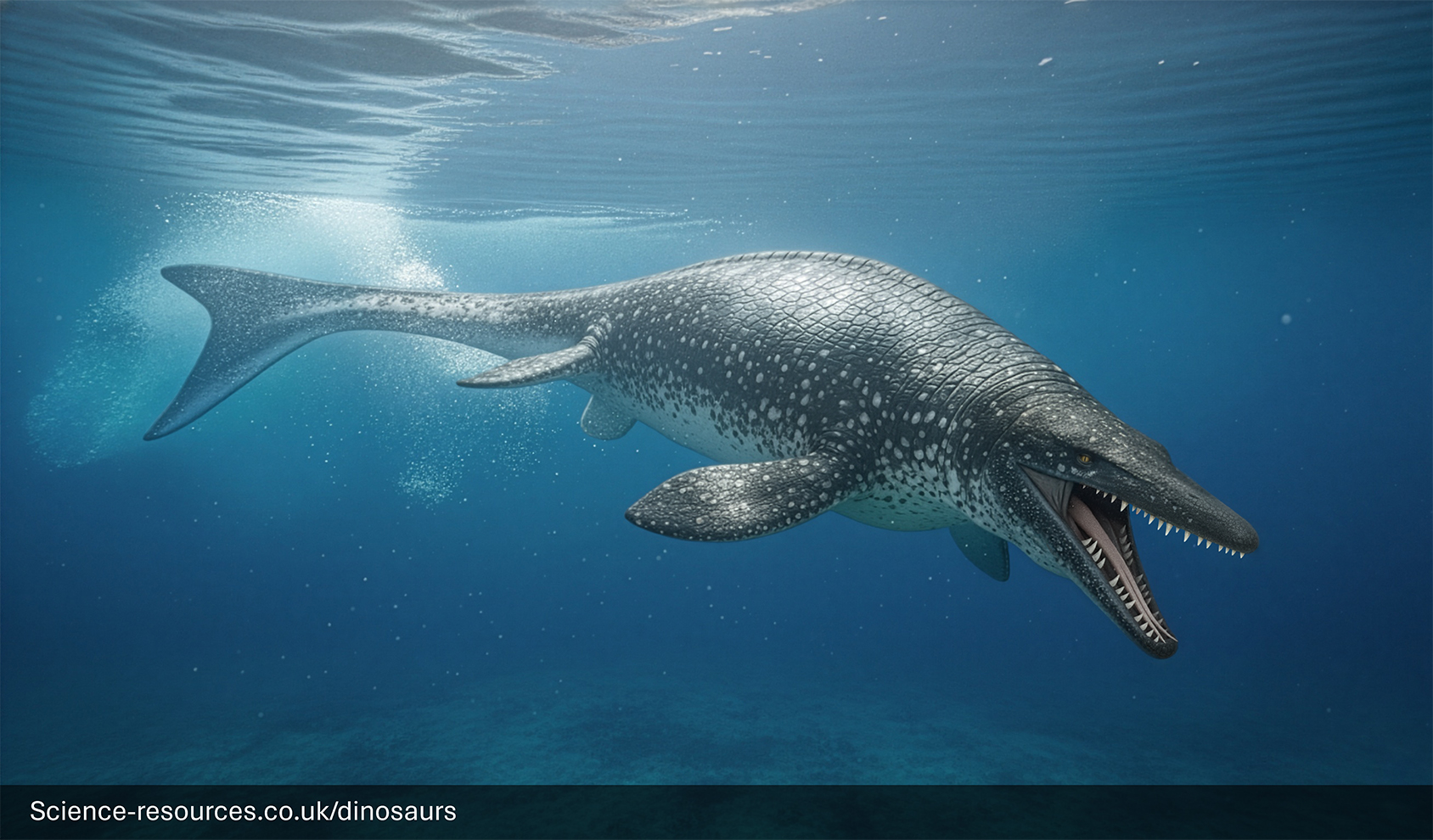 Modern Mosasaurus reconstruction (Image source: https://science-resources.co.uk/KS2/Dinosaurs/Mosasaurus.html)
Modern Mosasaurus reconstruction (Image source: https://science-resources.co.uk/KS2/Dinosaurs/Mosasaurus.html)
Mosasaurus Facts
|
Mosasaurus image courtesy of science-resources.co.uk |
Pronounced: mo-sa-SAW-rus Length: Up to 15 meters (50 feet) Diet: Carnivore (Fish, other marine reptiles) Time: Cretaceous - 145 to 66 million years ago Habitat: Open Seas Fossils Found: Europe, North America, South America. |
Mosasaurus size image courtesy of science-resources.co.uk
Speed: Mosasaurus could accelerate to top speeds of about 30 miles per hour, achieving this speed very quickly in a single second. This rapid acceleration was likely a key factor in its success as a predator, allowing it to ambush prey from a stationary position. Intelligence: Mosasaurus was a highly intelligent reptile, comparable to modern-day monitor lizards or potentially even more intelligent, but likely not as intelligent as modern whales. Its intelligence was based on a relatively large brain and well-developed cerebellum, suggesting advanced hunting behaviors like recognizing different prey and using ambush tactics. Fossil: The most famous Mosasaurus fossil is the holotype of Mosasaurus hoffmannii, discovered in the late 1700s in the chalk beds of Maastricht, Netherlands. Though it’s not a complete skeleton—mainly a well-preserved skull with some jaw fragments—it played a groundbreaking role in palaeontology. Originally mistaken for a whale or crocodile, it was later identified by Georges Cuvier as a marine reptile. This fossil helped introduce the concept of extinction and remains iconic in museums and scientific history. While more complete Mosasaurus specimens have since been found, the holotype’s historical significance makes it a cornerstone of marine reptile research. Mosasaurus belonged to the marine reptiles and was a member of the larger group called mosasaurs. Mosasaurus swam using a powerful, crescent-shaped tail fluke, similar to a shark’s. Its body stayed mostly stiff to reduce drag, while the tail provided strong thrust. Paddle-like flippers helped it steer through the water, making it a fast and agile predator in the ancient oceans. Mosasaurus was built for ocean life. Its streamlined body and powerful tail fluke made it a fast, agile swimmer, perfect for chasing prey. Flipper-like limbs helped it steer, while sharp teeth and extra jaws on the roof of its mouth ensured it could grip slippery fish and other marine animals. Its countershaded skin (dark on top, light underneath) helped it stay hidden from both predators and prey. These features made Mosasaurus a top predator in prehistoric seas. Mosasaurus was a marine reptile, not a dinosaur. It belonged to a group called mosasaurs, which were close relatives of modern monitor lizards and snakes. Evolving from land-dwelling reptiles, mosasaurs adapted to life in the ocean with flippers and powerful tails. Though they lived during the age of dinosaurs, their closest living relatives today are reptiles, not fish or marine mammals. Scientific and artistic views of Mosasaurus have transformed over time. Once imagined as a land-walking, crocodile-like creature, it’s now recognised as a fully aquatic marine reptile with a streamlined body and powerful tail fluke.
How fast could Mosasaurus move?
How smart was Mosasaurus?
How complete is the most famous Mosasaurus fossil?
Which family of reptiles did Mosasaurus belong to?
How did Mosasaurus move?
How did Mosasaurus's features affect its survival?
How was Mosasaurus related to other prehistoric animals?
How has the Appearance of Mosasaurus changed over time?
Early Depictions (19th Century):
Modern Understanding:
- Fully aquatic with flippers and a crescent-shaped tail fluke for propulsion.
- Swam like sharks, using a stiff body and strong tail.
- Fossil evidence shows diamond-shaped scales and countershading (dark back, light belly).
- Streamlined skull with hidden teeth and extra pterygoid teeth for gripping prey.
This evolution in understanding reflects advances in fossil discoveries and scientific techniques.
Frequently Asked Questions About Mosasaurus
Q1: What is a Mosasaurus?
A1: Mosasaurus was a large, marine reptile that lived during the Late Cretaceous Period, around 82-66 million years ago. Its name means "Meuse lizard" because its first fossils were found near the Meuse River in Europe.
Q2: How big was the Mosasaurus?
A2: Mosasaurus could grow up to 56 feet long, making it one of the largest marine predators of its time. It had a long, streamlined body and powerful tail for swimming.
Q3: What did Mosasaurus eat?
A3: Mosasaurus was a carnivore, meaning it ate meat. It likely fed on fish, squid, and other marine reptiles, using its sharp teeth and strong jaws to catch and eat its prey.
Q4: Where did Mosasaurus live?
A4: Mosasaurus lived in the oceans that covered what is now Europe, North America, and Africa. Fossils have been found in these regions, indicating it had a wide distribution.
Q5: What makes Mosasaurus different from other marine reptiles?
A5: Mosasaurus is known for its large size, powerful jaws, and double-hinged jaw structure, which allowed it to swallow large prey whole. It also had paddle-like limbs for swimming.
Q6: How did Mosasaurus move?
A6: Mosasaurus used its powerful tail to propel itself through the water. Its paddle-like limbs helped it steer and maneuver while swimming.
Q7: What did Mosasaurus look like?
A7: Mosasaurus had a long, streamlined body, a large head with sharp teeth, and paddle-like limbs. It also had a powerful tail that helped it swim quickly through the water.
Q8: Why is Mosasaurus important to scientists?
A8: Mosasaurus provides valuable insights into the evolution of marine reptiles and their adaptations to life in the ocean. Its fossils help scientists understand the diversity of marine life during the Cretaceous.
Q9: Where can I see a Mosasaurus skeleton?
A9: You can see Mosasaurus skeletons in several museums, including the Natural History Museum in London and the National Museum of Natural History in Washington, D.C.
Q10: What is the significance of the name Mosasaurus?
A10: The name Mosasaurus means "Meuse lizard," reflecting its discovery near the Meuse River in Europe. It was named by paleontologist William Conybeare in 1822.
You may also be interested in
- How big was Tyrannosaurus Rex?
- How big was Compsognathus?
- How big was Spinosaurus?
- How big was Velociraptor?
- How big was Dilophosaurus?
- How big were Dinosaurs?
Tags: How big was Mosasaurus; Mosasaurus; How fast was Mosasaurus, Mosasaurus size, how tall was Mosasaurus, Mosasaurus name mean, Mosasaurus height, height of Mosasaurus, Jurassic Park Mosasaurus, Jurassic World Mosasaurus, how big were Dinosaurs
